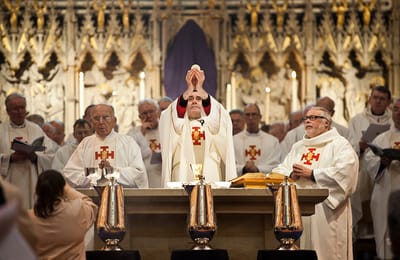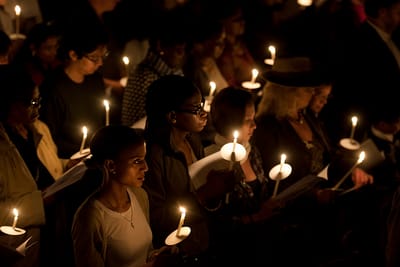what is mass/eucharist

What is the Mass/Eucharist
What is the Mass?The Mass (the Eucharist) is “the source and summit of the Church’s life”. In it, Christ is really, truly and substantially present under the appearances of bread and wine. Catholics listen to the Word of God and receive Christ’s Body and Blood, miraculously transformed from bread and wine, at Holy Communion. The Fathers of the Second Vatican Council describe the Mass in the following way: At the Last Supper, on the night when He was betrayed, our Saviour instituted the eucharistic sacrifice of His Body and Blood. He did this in order to perpetuate the sacrifice of the Cross throughout the centuries until He should come again, and so to entrust to His beloved spouse, the Church, a memorial of His death and resurrection: a sacrament of love, a sign of unity, a bond of charity, a paschal banquet in which Christ is eaten, the mind is filled with grace, and a pledge of future glory is given to us (Sacrosanctum Concilium 47). At Mass, the sacrifice of the Cross is renewed in an “unbloody manner”, as the memorial of Christ’s death. The liturgy of the Mass is itself divided into two parts. The first part is the liturgy of the Word, in which we listen to Christ speaking in the Scriptures. The second part is the liturgy of the Eucharist, where the sacrifice of Calvary is renewed. Strictly speaking, however, the entire Mass is one sacrifice. That is why it is sometimes called the “Sacrifice of the Mass”. (Photo: Mazur/CatholicChurch.org.uk)
Read More
The Mother of All Vigils
The Rev. Father Christopher Matthews, the Diocesan Master of Liturgical Ceremonies, reflects on the symbolism of the Easter Triduum ‘May the light of Christ rising in glory dispel the darkness of our hearts and minds.’ These are the words of the priest on Holy Saturday as the paschal candle is lit at the great Easter Vigil. The Easter Vigil has often been described as The Mother of all vigils; it is in so many ways the highlight of the Church’s year. The Easter Vigil is the culmination of the week that tells the story of Christian salvation. That week begins with Palm Sunday, the blessing of palm branches and a procession into church. Here at The Cathedral, that procession is lead by a donkey, a reminder of the way Christ entered the City of Jerusalem in great triumph, the people waving palm branches in celebration. We continue to wave branches as we enter the church building that day in great joy, a joy that soon turns sombre as we hear the reading of the Passion narrative. We leave the church that day knowing what the week ahead holds, we’ve already heard a synopsis of what is to come. In our diocese, we gather together with our Bishop on the Wednesday of Holy Week to celebrate the Chrism Mass. It is an occasion of great joy, as the whole diocese, people, priests, deacons and religious gather together as the Sacred Oils, to be used through out the diocese in the coming year, are consecrated. The occasion is also the time for the priests to renew their dedication to serve the people of our diocese. They resolve to continue to be faithful ministers of God’s Word, to celebrate the Eucharist and to imitate Jesus Christ the Head and Shepherd of the Church. This Mass is in many ways the model celebration of the Eucharist; the Bishop surrounded by the presbyterate, the deacons and people of the Diocese, the local Church gathered around the table of God’s Word and the table of the Eucharist to be nourished. The following day brings us to the great Triduum, which begins with the Mass of the Lord’s Supper on Holy Thursday. This is the first part of a three part drama that runs until the end of the Easter Vigil. The atmosphere for the Mass of the Lord’s Supper, although joyful, is some what muted. There is a dignity about the celebration as the Washing of the Feet unfolds, recalling us to Saint John’s Gospel and Christ’s message to his disciples, and to us, ‘I have given you an example so that you may copy what I have done to you.’ (John 13:15) A reminder to us all, that our faith is one of service to others, we are each called to put our faith into action, to bring the Lord’s love to bear on the world in which we live. The Mass of the Lord’s Supper draws to a close as the Blessed Sacrament is carried in solemn procession from the altar to a place of repose. There the Lord rests as we watch, waiting, praying. Part two of the drama takes place on Good Friday. As we arrive in church to celebrate the Lord’s Passion we are struck by the stark bareness, the building stripped of all its adornment, the flowers are gone, banners taken down, the altar bare. As the Roman Missal reminds us ‘On this and the following day, by a most ancient tradition, the Church does not celebrate the Sacraments at all, except for Penance and the Anointing of the Sick.’ (page 346). The day is one of fasting and abstinence. All the outside distractions are removed to allow us to reflect, and focus, on the great act of love that Jesus carries out for each and everyone one of us, it was His love for us that held him to that tree. Today’s liturgy is particularly solemn; as we drift back out into the sunlight, we do so quietly, subdued by the experience of venerating that cross that becomes the tree of life. The final act of this three part drama takes place after dark on Holy Saturday. As the paschal candle is carried into a darkened church, the light beginning to spread and cast away the shadows, we hear the ancient hymn of rejoicing, the Exsultet, and so the scene is set for this Mother of all Vigils to take us on a journey through salvation history. A story we only understand in the light of the Risen Christ, and that is symbolized by the paschal candle taking its place right next to the ambo, its light illuminating the scriptures for us. This is the night we celebrate that the Lord has truly risen, risen to bring us new life. Many books, articles, tweets, and blogs have been written about Holy Week and the great symbolism of the liturgies that mark the week. None of these words can ever fully express the atmosphere, sights and sounds of this great week, they have to be experienced. I hope you seize the opportunity to do so. This article first appeared in the Lent/Easter 2012 edition of the Shrewsbury Catholic Voice
Read MoreOrdinary Time
Today we resume regular time. Indeed, this weather has two sides. The first begins the Monday following the Feast of the Lord's Baptism and runs until the day leading up to Ash Wednesday. The second begins today, the Monday after the solemnity of Pentecost, and will run until the Saturday leading up to the 1st Sunday of Advent. Ordinary Time consists of 33 or 34 weeks, depending on the year. The way to count the weeks is: 1. - The week in which the Lord's Baptism is celebrated is the first week. The following weeks are counted in progressive order until the start of Lent. 2. - After Pentecost, there are two options: a) If the weeks in Ordinary Time are 34, take the series again from the week following the one that was interrupted with the start of Lent. For example, if in the V week in Ordinary Time falls on Ash Wednesday, the Monday following Pentecost will be Monday of the VI week in Ordinary time. b) If the weeks in ordinary time are 33 omit the week after which it was interrupted with the beginning of Lent, and resume the series in which follows the omission. For example, if in the V week in Ordinary Time falls on Ash Wednesday, the Monday following Pentecost will be Monday of the VII week in Ordinary time. This second is what happens in this 2022, because we were in week VIII of ordinary time when Lent began, and being 33 weeks, we omitted IX, and resumed in X.
Read More